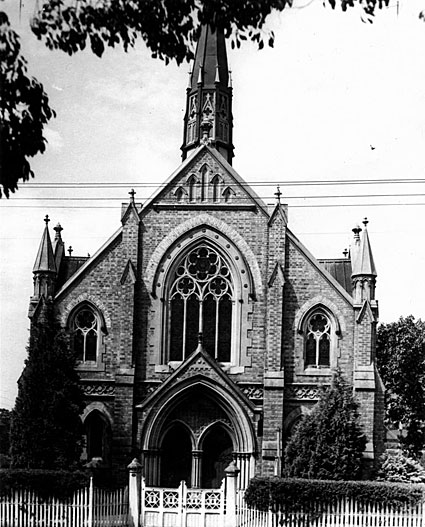
The Methodist Church, Fortitude Valley (1949)
[Photograph: John Oxley Library, State Library of Queensland]

The Methodist Church, Fortitude Valley (1949)
[Photograph: John Oxley Library, State Library of Queensland]
Historical and Technical Documentation by Geoffrey Cox
© OHTA 2011, 2013 (last updated April 2013)
The Fortitude Valley Wesleyan Church became independent of the Albert Street Church in Brisbane in 1867. Two other church buildings at Fortitude Valley preceded the one opened there in October 1888.1 Official opening services in the new church were held on Sunday 13 January 1889.2 The building was designed by the Brisbane architect and civil engineer George S. Simkin, amongst whose work this is his best known building.3 It served for nearly one hundred years as the centre of Methodist worship for Brisbane's northern suburbs.
The building became redundant following the formation in 1977 of the Uniting Church in Australia. It is now used for commercial purposes.
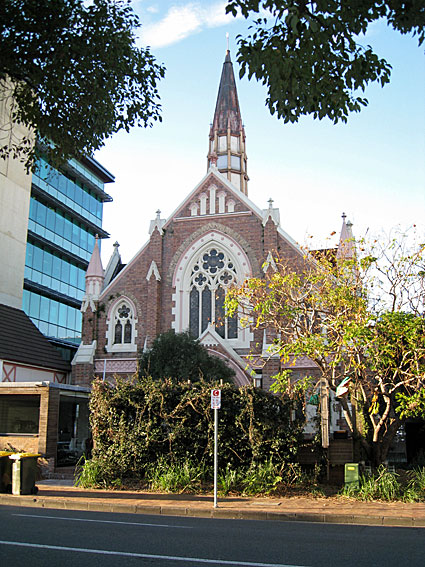
The former Methodist Church, Fortitude Valley
[Photograph by Geoffrey Cox (July 2011)]
The organ built for this church in 1888 by Edward F. Waldron was of historical importance in that it was one of the earliest organs built in Queensland.
There were plans for an organ at Fortitude Valley as early as 1876, when the first of a series of lectures was given in aid of the organ fund.4 Several options were considered in choosing a builder: The organist of the Albert Street Wesleyan Church, James Lord, wrote to the church in August 1887, offering advice on the size of the organ chamber and the general scale of the organ;5 while Messrs W.H. Paling of Toowoomba wrote in September and October 1887 forwarding details of an organ that could be supplied by E.F. Walcker of Germany.6
By early 1888, the decision had been made to have the organ made locally by Edward F. Waldron of Paddington in Brisbane. This was an adventurous move, encouraged by the fact that Waldron was able to provide to the church trustees a testimonial from John Nicholson of Worcester, the organ builder to whom he had been apprenticed in March 1858 at the age of 14.7 The following is a copy of the contract signed by Waldron with the Fortitude Valley church in February 1888:
MEMORANDUM AGREEMENT MADE 30th day of February One Thousand eight hundred and eighty eight, between EDWARD F. WALDRON of Bellemount Estate, Fernberg Road, Paddington, Organ Builder of the one part and GEORGE DOWN of Brisbane for and on behalf of the Trustees of the Valley Wesleyan Church of the other part, WHEREAS it is agreed between the parties as follows:-
The said Edward F. Waldron shall at his own cost, charges, and expenses, build and construct in a good and substantial and workman[like] manner a Church or Pipe Organ of the size, quality and description and in every respect conformable with the specification and particulars hereunto annexed marked "A" and signed by the respective parties and subject to the conditions and stipulations therein and herein contained for the price or sum of Four Hundred Pounds.
The said Organ to be erected and placed in a complete and perfect state and condition in the apse of the New Wesleyan Church now being built in Brookes St., Fortitude Valley to the satisfaction and approval of any two competent and disinterested judges or inspectors who may be appointed by the said Trustees and shall be at liberty to inspect the material and workmanship of the Instrument from time to time whilst in process of construction and generally to supervise the construction thereof with power to order and alterations or improvements which in the opinion of such judges shall be necessary or desirable PROVIDED THAT SUCH ALTERATIONS or improvements shall not substantially interfere with the size and design of the organ.
The time for the completion of the organ to be eight months from the first day of December One Thousand eight hundred and eighty seven.
On the due completion and fulfillment of this contract and on production of a Certificate in writing signed by the two judges to be appointed as herein provided of their satisfaction and approval, the Trustee parties hereto of the second part shall and will pay the said Edward F. Waldron the said price or sum of Four Hundred Pounds.
As witness to the hands of the parties the day and year above written
Witness to the signature of
Edward F. Waldron
(signed) M. Harrington
Brisbane
signed Edward F. WaldronWitness to the signature of
George Downs for and on behalf
of himself and the Trustees
(unsigned)
(unsigned)
The metal pipes to be of the best spotted metal and of suitable thickness, wood pipes up to four feet inclusive to be of [pine?] and to be thoroughly well seasoned and of best construction. In addition to being well and properly glued they must be screwed and pegged and the larger sizes are to be bound at the top, the inside of each is to have a coating of size or some other suitable liquid and the outside to be varnished with two coats of the best varnish. All pipes to be of full Cathedral scale cut up, and for 2-1/2" wind. All Bourdon pipes to be full in swell box and not mitred. Special care, skill and attention must be bestowed on the VOICING as the tone of each stop must be of a thoroughly distinctive timbre and perfect throughout and of the purest quality, and to be full and of the latest and best construction.
Swell box to be 1-1/2" thick and to be lined with suitable material. Shutters to be balanced and to stand closed or open as desired.
Bellows to be of ample size to supply sufficient wind not only for the full power of the organ according to the present specification, but also for an extra 16ft. stop in case the same may be added in the near future.
Action to be all constructed of the best material and the whole to be of the latest and most improved principle, all material to be of the best and [... ?] suitable description and of first class quality and all the workmanship throughout to be equal to that of the best English organ builders.
The case and front to be according to the design prepared by the Architect of the Church so as to correspond with the internal fittings of the building.
The builder to erect the instrument in the West Apse in the church in complete and perfect order and to guarantee to keep it in proper condition and perfect tune for twelve months from the completion.
(Signed) Edward F. Waldron
SPECIFICATION OF THE PIPE ORGAN TO BE BUILT BY MR. EDWARD F. WALDRON, Bellemount Estate, Fernberg Road, Paddington for the Trustees of the New Valley Wesleyan Church.
1.
2.
3.
4.
5.
6.
7.
Stopped Diap.
Dulciana (grooved)
Principal
Flute
Flautina
(Slide for 12th. or 15th.)
8ft
8ft
4ft
4ft
2ft
Wood
Metal
Metal
Wood
Metal
56 pipes
44 pipes
56 pipes
56 pipes
56 pipes
1.
2.
3.
4.
5.
6.
7.
8.Bourdon
Open Diapason
Lieblich Gedact
Viol de Gamba (grooved)
Principal
Fifteenth
Mixture
Oboe
8ft
8ft
8ft
4ft
2ft
2 ranks
8ft
Metal
Wood
Metal
Metal
Metal
Metal
Metal
56 pipes
56 pipes
44 pipes
56 pipes
56 pipes
56 [sic] pipes
56 pipes
1.
1. Bourdon
(small scale well cut up)
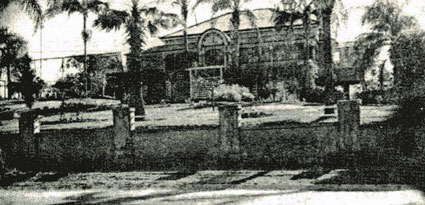
Edward Waldon's house in Rockbourne Terrace, Paddington,
where the organ was built
[Photograph from E.R. Salisbury, A brief history of the pipe organ
in the former Valley Methodist Church, Brisbane (1982)]
Edward Francis Waldron, the son of John and Harriet Waldron, appears to have been born in St Peter, Worcestershire, England, around 1844, and to have emigrated to Queensland in 1883, arriving in Cooktown on 7 July. He died in Brisbane on 18 February 1889.9 It was reportedly during the construction of the Fortitude Valley organ that Waldron died of typhoid fever, and the instrument is said to have been completed by Thomas C. Christmas.10
A newspaper report of September 1888, given below, suggests that this notably Queensland-built organ was all-but-complete by that time, awaiting only the arrival of the metal pipes from London. It also gives further details of the local timbers employed by Waldron, a description of a special tuning mechanism devised by him, and evidence that he had at one time been employed also by the organ builders Foster and Andrews of Hull. Although the report of September 1888 refers to metal pipes imported from London, there is evidence in the Fincham Letter Books that the Oboe stop was supplied by George Fincham of Melbourne in January 1889.11
A QUEENSLAND BUILT ORGAN
The Trustees of the Fortitude Valley Wesleyan Church several months ago determined to procure a pipe organ of a character and size suited to the new church, which is now approaching completion. It was at first proposed to send to one of the best English makers for the instrument, but it chanced to come to the knowledge of the trustees that there was resident in Brisbane a gentleman of great experience in the art, who desired an opportunity of proving whether an instrument could be made here of equal quality with those produced by the best English makers and at similar cost. The trustees decided to give this organ builder, who proved to be Mr Edward F. Waldron, of Paddington, a chance of showing what he could do.
Specifications were drawn up by Mr George Down for an instrument to be provided with two manuals, compass CC to G, 56 notes, radiating and concave pedals CCC to F, 2-1/2 octaves, and the following stops:- Great organ: Open diapason, 8ft.; stopped diapason, 8ft.; dulciana, 8ft.; principal, 4ft.; flute, 4ft.; flautina, 2ft.; 7th prepared slide for 12th. Swell organ: Bourdon, 16ft.; open diapason, 8ft.; lieblich gedact, 8ft.; gamba, 8ft.; principal, 4ft.; 15th, 2ft.; mixture, 2ft.[sic]; oboe, 8ft. Pedal organ: Bourdon, 16ft. Couplers: Great to Pedal; swell to pedal; swell to great, and then composition pedals each to swell and great. It is also expressly stipulated that the materials and workmanship throughout should be in all respects equal to that which is found in instruments turned out by the best English makers. Mr. Waldron willingly accepted these conditions, although, considering that he had not previously built an organ in the colonies and could not of course be assured that the timber available was entirely suitable, they might have been regarded as somewhat exacting. He went about his work in a systematic manner. For the first few months he was doing little else but making preparations. The timber which he judged to be the best for the purpose was purchased and carefully seasoned, and while this process was going on, Mr Waldron was engaged in the construction of the smaller fittings.
Now the organ is complete, all but the metal pipes, which are daily expected from London. With the exception of these pipes and the ivory for the keys, the whole mechanism of the instrument has been made by Mr Waldron and his assistants from Queensland material - the ebony for the black keys even is the growth of this colony's forests. The frame and pedals of the organ are of hardwood, the pipes and draw-stop rods are of pine, and the trackers of cedar. So far the timber used has answered admirably, and there have been no indications of warping, and no "sypher" from the pallets of any of the pipes already in position.
In this organ Mr Waldron has introduced an invention of his own, whereby the stoppers of the pipes may, for tuning purposes, be raised or depressed by means of a screw instead of by hammering or "coneing", as is the usual style. This should enable the tuner to work more rapidly, and certainly will obviate any chance of the pipe being thrown out of voice. Instead of using rollers for the swell action, Mr Waldron has introduced skew levers, which will save a large amount of friction and wear and tear, and prevent "sticking".
A number of organists have frequently examined the instrument while it was in course of construction, and their unanimous verdict is that the workmanship is of very high quality. As Mr Waldron was for many years in the employ of Nicholson, the organ builder of Worcester, and also of Foster and Andrews, at Hull, it is confidently expected that this organ will be a really first-class job, and its opening is looked forward to with much interest in musical circles. As soon as the windows are in the church, Mr Waldron will begin to erect the organ.12
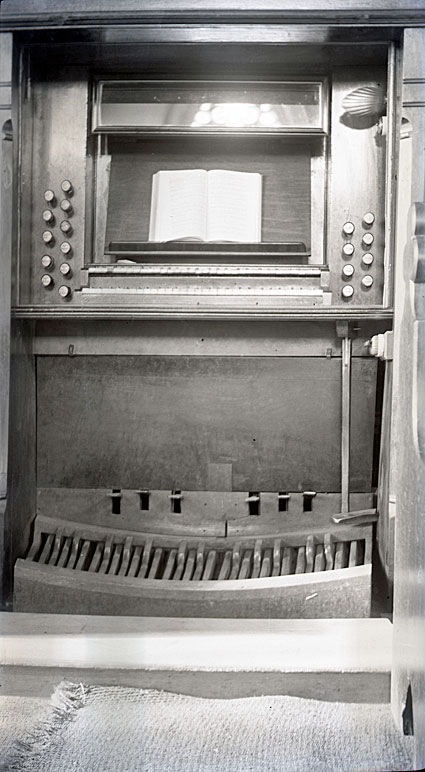
Edward Waldon's draw-stop console
[Photograph from E.R. Salisbury, A brief history of the pipe organ
in the former Valley Methodist Church, Brisbane (1982)]
It was once conjectured that Waldron's instrument may have been the earliest example of organ building commenced in Queensland,13 but this can now be shown to be incorrect. The organ built by Mr B.B. Whitehouse and installed in August 1888 at St Thomas' Anglican Church, Toowong, was similarly once thought to have been the first organ 'completed' in Queensland. The Toowong organ, however, is now known to have been built in 1885-86,14 and was therefore commenced before Waldron's organ. In any case, both of these instruments were preceded by the one built by Thomas C. Christmas and installed in 1882 at St Patrick's Catholic Church, Fortitude Valley.
There appears to be no record of the date of completion of Waldron's organ. It may be assumed, however, that it was completed early in 1889, as the imported pipes and blower had arrived by November 1888.15
The organ was only partially in operation when the church was opened on Tuesday 15 January 1889, with Mr S.G. Benson presiding at the organ:
A tea and public meeting to celebrate the opening of the new Wesleyan Church in Fortitude Valley was held last evening. . . At intervals between the address the choir, under the conductorship of Mr George Down sang the "Kyrie," "Gloria," "Et incarnatus," and "Dona nobis," from Farmer's Mass in B flat. Mr S. G. Benson, R.A.M. presided at the organ, and it had been proposed that the musical portion of the proceedings should partake something of the nature of an organ recital. Unfortunately it was found impossible to get the instrument quite ready in time. The builder, Mr. Waldron, in the erection of the organ, has laboured under great inconvenience as owing to the carpenters being at work in the church all last week, and necessarily hammering a good deal, he has not been able either to tune the pipes quite satisfactorily or to get some important stops into position. The recital was consequently postponed until a future date. Judging from the quality of so much of the organ as could be used last evening it should turn out an excellent instrument. Its power has been admirably gauged to suit the size of the building, which its tones fill. Their reverberations, however, are never so forcible as to render them disagreeable to the ear. In the hands of so competent an organist as Mr. Benson, the attendants at the Valley church may expect to hear high class music faithfully interpreted on this instrument when it is completed. . . .16
Samuel Benson's involvement in the opening of the Wesleyan church at Fortitude Valley in January 1889 seems to have coincided with his arrival in Brisbane.17 This was after a brief period in North Queensland, where he was first appointed organist at St James' Anglican Cathedral, Townsville, before moving to Charters Towers. His first appointment in Brisbane was at the Fortitude Valley Wesleyan Church, after which he moved for a brief period to St Paul's Presbyterian Church.18
The organ at Fortitude Valley was certainly in operation by Tuesday 8 July 1890, when Benson gave a successful organ recital and sacred concert there, described as the third of a series.19 It appears to have been after this that Benson was succeeded as organist at Fortitude Valley by Edwin Lloyd.
'The first of a series of popular organ recitals by Mr E. Lloyd (late organist of St Stephen's, Richmond, Melbourne)' was given in the Fortitude Valley church on Monday 6 October 1890, 'when a collection [was] . . . made in aid of the organ fund.'20 Lloyd was named as the organist for a Service of Praise there in June 1891,21 and also in September 1892, when S.G. Benson presided at the organ in an organ recital and sacred concert given by the combined choirs of the Albert-Street and Valley churches, supported by an orchestra.22
Benson moved from St Paul's Presbyterian Church to the Albert Street Wesleyan Church in May 1892,23 and Lloyd appears to have succeeded him in turn at St Paul's. Certainly by July 1893, when Lloyd gave a recital at Albert Street Wesleyan Church, he was described as organist and choirmaster of St Paul's Presbyterian Church.24 Details of a 'benefit' held for him in July 1900 reveal that he was overcome by severe illness at the end of the 1890s:
Benefit for Mr E. Lloyd
A meeting of ladies and gentlemen (Mr. G. Down presiding) connected with the musical profession was held yesterday afternoon at Mr S. G. Benson's rooms for the purpose of taking steps to tender some assistance to Mr. Edwin Lloyd, who was so long well and popularly known in musical circles in both Brisbane and Ipswich. Mr Lloyd, in consequence of severe illness, has been unable to follow his profession for some time past. For a considerable period he was the organist at the Valley Wesleyan and St Paul's Presbyterian Churches respectively, and he always took a deep interest in everything that tended for the advancement of music in the metropolis. He was conductor for some time of the Ipswich and Blackstone Choir, which under his leadership competed successfully at the annual Eisteddfod gatherings. After some discussion the meeting decided that a subscription list should be opened in the room, and the sum of 18 guineas was promised. . . . It was further decided that a benefit concert should be given on his behalf on a date to be fixed . . . .25
Problems arose with the organ at Fortitude Valley in the mid-1890s, and there was a concert in the school hall in November 1894 in aid of the fund for repairing it.26 The instrument was re-opened in May 1895 with a choral and orchestral concert in which the choir numbered 'over fifty selected voices,' under the direction of Mr G. Down. Samuel Benson again provided organ accompaniments and solo items, although it was noted that the organ was 'less pretentious and complete than his own [at Albert Street].' The explanation for the re-opening was as follows:
The organ having been, through various defects, chiefly in connection with the bellows, shut up for over eighteen months, it was in the beginning of the year placed in the hands of Mr. B. B. Whitehouse, of Adelaide-street, to be thoroughly overhauled and renovated. He has just completed his contract under the supervision of Mr. Benson . . . .27
Another notable, though brief, appointment to the position of Organist and Choirmaster at Fortitude Valley was Robert Dalley-Scarlett, who moved there after resigning from his post at St Andrew's Presbyterian Church, Creek Street in June 1932. He moved on to take up the post of Organist at All Saints' Church of England, Wickham Terrace in 1934.28 At Fortitude Valley, Dalley-Scarlett organised a notable Handel Festival, and it was also during his time there that a tremulant was added to the organ. The latter derived from the Willis organ at the Exhibition Building, which had been rebuilt a few years earlier and moved to the Brisbane City Hall.29 The date given in another source for this addition at Fortitude Valley is 1932.30
Dalley-Scarlett was succeeded in 1935 as organist at Fortitude Valley by Edward R. Salisbury, who held the post until 1942. Salisbury oversaw the rebuilding of the organ in 1937 by Whitehouse Bros of Brisbane,31 but the relevant entry in the firm's ledger suggests that the project had been planned as early as 1934:
1937: - Reconstruction of pipe organ as per
tender dated 13/9/1934. - £550
- Addition of 2 extra couplers.32
In the process of rebuilding the organ at this time, the original soundboards were replaced by the cone-pallet type, and the action was converted to tubular pneumatic. Two stops (Bourdon 16ft and Mixture II) were transferred from the Swell to the Great, and three (not two) additional couplers were provided. The original straight concave pedalboard was replaced by a radiating-concave one, and the manual compass was increased from 56 notes to 61 notes.33 From 1937, therefore, the organ resembled in many respects the standard Whitehouse tubular-pneumatic instrument of the time, with a stop-key console using the inclined-block stop-keys above the Swell manual:
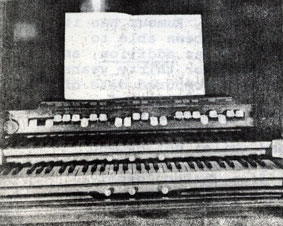
The Whitehouse Bros stop-key console of 1937
[Photograph from E.R. Salisbury, A brief history of the pipe organ
in the former Valley Methodist Church, Brisbane (1982)]
| GREAT Bourdon 16 Open Diapason 8 Stop Diapason 8 Dulciana 8 Principal 4 Flute 4 Flautina 2 Mixture II SWELL Open Diapason 8 Gedact 8 Gamba 8 Principal 4 Fifteenth 2 Oboe 8 PEDAL Bourdon 16 COUPLERS Swell to Great Swell to Pedal Great to Pedal Swell Super Swell Sub to Great Swell Super to Great |
16 8 8 8 4 4 2 II 8 8 8 4 2 8 16 |
[originally on Swell] [originally on Swell] [gvd bass] |
Swell tremulant
Attached stop-key console
Balanced swell pedal
2 pistons & cancel to Great Organ (blind)
2 pistons & cancel to Swell Organ (blind)
Pedalboard: radiating concave
Tubular-pneumatic action
Compass: 61*/30.34
* The mixture appeared in 1974 not to have been extended to 61 notes.
The Fortitude Valley Methodist Church became redundant upon the formation of the Uniting Church in Australia in 1977, and the organ was removed to storage around 1982. There was an intention that it be installed eventually at the Southport Uniting (formerly Methodist) Church, and it was purchased for this purpose by David Rowley and stored under his residence at 56 Alicia Street, Southport.
The organ's fate remained uncertain for many years, and it was purchased in 1998 by St Mark's Anglican Church, Clayfield.35 The proposal to install it there, however, was thwarted. Before the end of 1999 it had been purchased by Dr Rod Catton of Innisfail for rebuilding and enlargement as a residence organ.36
The sad end to the tale of this historic instrument is that very little that can be attributed to Waldron survives: Notwithstanding the changes made in 1937, the conditions of storage over almost two decades led to serious deterioration. Nothing but the pipework of the original instrument was deemed salvagable by 2002,37 and only a small proportion of this (the wooden pipes) was made by Waldron in any case.
_______________________________________________________________________
1 R.S.C. Dingle, Annals of Achievement: A Review of Queensland Methodism 1847-1947 (Brisbane: Queensland Book Depot, 1947), p. 199; E.R. Salisbury, A brief history of the pipe organ in the former Valley Methodist Church, Brisbane (Brisbane: privately printed, 1982).
2 The Brisbane Courier (12 January 1889), p. 1; 'Diary of Events' for 13 January 1889, in Pugh's Queensland Almanac ... for 1890.
3 Donald Watson & Judith McKay, Queensland Architects of the 19th Century: A Biographical Dictionary (Brisbane: Queensland Museum, 1994), p. 161.
4 The Week, vol. 2, no. 50 (9 December 1876), p. 677.
5 Letter from James Lord to George Down, 1 August 1887; copied in 1937 from the archives of the Fortitude Valley Methodist Church by Edward R. Salisbury, and supplied to G. Cox in July 1974; reproduced as Appendix C in Salisbury, A brief history, op. cit.
6 Letters from W.H. Paling & Co. to George Down, 13 September & 7 October 1887; copied in 1937 from the archives of the Fortitude Valley Methodist Church by Edward R. Salisbury, and supplied to G. Cox in July 1974; reproduced as Appendices D, E and G in Salisbury, A brief history, op. cit.
7 Testimonial by John Nicholson dated 26 February 1881, and Indentures of Edward Frances Waldron dated 5 March 1858; copied in 1937 from the archives of the Fortitude Valley Methodist Church by Edward R. Salisbury, and supplied to G. Cox in July 1974; reproduced as Appendices F and H in Salisbury, A brief history, op. cit.; also in E. R. Salisbury, 'Work of a Queensland pioneer to be preserved,' OHTA News, vol. 2, no. 4 (October 1978), p. 13.
8 From the archives of Fortitude Valley Methodist Church, copied in 1937 by Edward R. Salisbury, and supplied to G. Cox in July 1974.
9 Ancestry.com. 1851 England Census [database on-line]; Queensland Australia, Passenger Lists, 1848-1912 [database on-line]; Australia Death Index, 1787-1985 [database on-line]. Provo, UT, USA: Ancestry.com Operations, Inc., 2010 - accessed April 2013.
10 Personal communication to G. Cox from Mr E.R. Salisbury (organist of Fortitude Valley Methodist Church 1935-42), 1974, based on an interview (c.1937) with Mr Hall of Podmore & Hall, who built the bottom octave of the Open Diapason; Notebooks of Mr E.R. Salisbury (undated).
11 George Fincham Letter Book 6, p. 245 (27 December 1888); p. 267 (25 January 1889); p. 273 (25 January 1889) (State Library of Victoria).
12 The Brisbane Courier (28 September 1888), p. 6.
13 Salisbury, A brief history, op. cit.; Salisbury, 'Work of a Queensland pioneer,' op. cit., pp. 10-11.
14 Geoffrey Cox, 'B.B. Whitehouse and the First Organ Built in Queensland,' OHTA News, vol. 35, no. 1 (January 2011), pp. 19-24.
15 Letter from George Down to The Collector of Customs dated 24 November 1888; copied in 1937 from the archives of the Fortitude Valley Methodist Church by Edward R. Salisbury, and supplied to G. Cox in July 1974; reproduced as Appendix I in Salisbury, A brief history, op. cit.
16 The Brisbane Courier (16 January 1889), p. 6.
17 Euterpe, 'Musical Echoes,' The Queenslander (30 March 1889), p. 600.
18 F. D., 'Men We Meet: Mr. S. G. Benson,' The Queenslander (27 February 1897), p. 465.
19 The Brisbane Courier (9 July 1890), p. 6.
20 The Brisbane Courier (6 October 1890), p. 4.
21 The Brisbane Courier (1 June 1891), p. 4.
22 The Brisbane Courier (22 September 1892), p. 4.
23 The Brisbane Courier (9 May 1892), p. 4; The Brisbane Courier (28 May 1892), p. 5.
24 The Brisbane Courier (17 July 1893), p. 4.
25 The Telegraph (19 July 1900), p. 5.
26 The Brisbane Courier (7 November 1894), p. 4.
27 The Brisbane Courier (18 May 1895), p. 6.
28 P. Roennfeldt, 'Dally-Scarlett, Robert,' in The Oxford Companion to Australian Music (Melbourne: Oxford University Press, 1997); Records of St Andrew's Uniting Church, Creek Street, Brisbane.
29 Salisbury, A brief history, op. cit., p. 8; Salisbury, 'Work of a Queensland pioneer,' op. cit., p. 12.
30 Notes provided to G. Cox by Frederic Rogers, January 1973.
31 Salisbury, A brief history, op. cit., pp. 8-10.
32 Whitehouse Bros Ledger (1922-1940), p. 605 [see also p. 221].
33 Salisbury, A brief history, op. cit., Appendices A & B;
34 Specification noted by G. Cox, March 1974.
35 The Organ Voice, vol. 24, no. 3 (September 1998), pp. 18-19.
36 The Organ Voice, vol. 25, no. 4 (December 1999), p. 28.
37 Personal communication from Simon Pierce to G. Cox, January 2002, at which stage the remnants of the instrument were stored in Simon Pierce's factory.